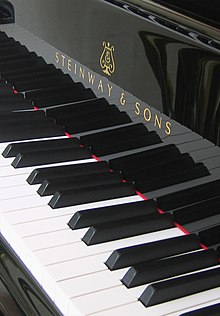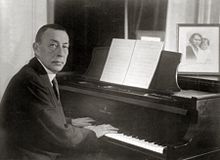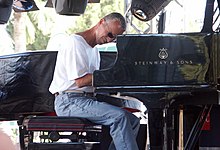Steinway & Sons
[21] The dominant position has been criticized, with some musicians and writers arguing that it has blocked innovation and led to a homogenization of the sound favored by pianists.
The award was given in recognition of Steinway's "overall performance, quality, value-added products, a well-executed promotional program and disciplined distribution which generated the most impressive results in the entire music industry.
Number 483 was sold to a New York family for $500, and is now on display at the Städtisches Museum Seesen,[37][38] the town in which Heinrich Engelhard Steinweg began his career as a piano maker.
[40] By the 1860s, Steinway had built and moved into a factory at Park Avenue between 52nd and 53rd Street (the present site of the Seagram Building) where it covered a whole block.
[41] The pianos themselves underwent numerous substantial improvements through innovations made both at the Steinway factory and elsewhere in the industry based on emerging engineering and scientific research, including developments in the understanding of acoustics.
According to journalist James Barron's account of Steinway's participation in the competition, the company was able to secure success by bribing one of the judges.
[54] In subsequent years Steinway was granted royal and imperial warrants from the rulers of Italy, Norway, Persia, Portugal, Romania, Russia, Spain, Sweden, and Turkey.
[75] During World War II, the Steinway factory in New York received orders from the Allied Armies to build wooden gliders to convey troops behind enemy lines.
It was a small piano that four men could lift, painted olive drab, gray, or blue, designed to be carried aboard ships or dropped by parachute from an airplane to bring music to the soldiers.
[85][86] In 2003, Steinway celebrated its 150th anniversary at Carnegie Hall with a three-day concert series with performances by Peter Cincotti, Art Garfunkel, Herbie Hancock, Ben Heppner, Ahmad Jamal, Ramsey Lewis, Randy Newman, Roger Williams, Nancy Wilson, Yundi Li and Eroica Trio, among others.
[88][89][90] As part of the 150th anniversary, fashion designer Karl Lagerfeld created a commemorative Steinway limited edition grand piano.
[92][93] As part of the celebration, a 125th anniversary Steinway limited edition grand piano was designed by Count Albrecht von Goertz.
[96] In 1972, after a lengthy strike, a long-running financial struggle, high legal expenses, and a lack of business interest among some of the Steinway family members, the firm was sold to CBS.
The Steinway Musical Instruments board recommended that shareholders accept this, and in September 2013 Paulson announced completion of the acquisition.
[104][105] After the 2008 economic downturn, Steinway grand piano sales fell by half, and 30 percent of the union employees were laid off at the New York factory between August 2008 and November 2009.
[111] Wayne Stahnke's technology, originally called Live Performance Model LX, was sold to Steinway in 2014 and re-branded as Spirio.
[115][116] As of early 2021, Paulson & Co. remains the ultimate parent of Steinway & Sons, with head office at 1251 Avenue of the Americas, New York, NY 10020.
The price of a used Steinway can vary tremendously, depending on the model (size), age, condition, and the quality of any restoration work that has been done.
It is decorated with coats of arms of the thirteen original states of America and painted by Thomas Dewing with dancing figures representing the nine Muses.
[69][72] The Sound of Harmony is decorated with inlays of 40 different woods, including the lid, which replicates artwork by Chinese painter Shi Qi.
[138] Some pianists and technicians have expressed a preference for pianos from Steinway's Hamburg factory over those made in New York, or vice versa.
[50] Emanuel Ax, concert pianist and piano teacher at the Juilliard School,[139] has said that "... the differences have more to do with individual instruments than with where they were made.
The diaphragmatic soundboard, which was granted a patent in 1936,[154] tapers in thickness from the center to the edges, which permits more freedom of movement resulting in a richer and more lasting tonal response.
[156] In 1962, the New York factory introduced the Permafree action for its grand pianos, using Teflon parts in place of cloth bushings.
The strings are uniformly spaced with one end coiled around the tuning pins, which in turn are inserted in a laminated wooden block called the pinblock or wrestplank.
[162][163][164] The pinblock, also known as wrestplank, in Steinways is made of seven layers of hard-textured wood that are glued together, set at a 45° angle to the run of the grain.
[173] Later the Polish pianist Ignacy Jan Paderewski toured America playing 107 concerts on Steinway pianos in 117 days.
[168][170][178][179] Some examples of Immortal Steinway Artists are Irving Berlin, Benjamin Britten, George Gershwin, Vladimir Horowitz, Cole Porter, and Sergei Rachmaninoff.
More generally, Stuart de Ocampo endorses the view of Donald W. Fostle, who wrote in a company history of Steinway that "the genius of Steinways ... ultimately lay in their ability to persuade millions of persons across decades and continents that in this realm of supreme subjectivity, individual variation, incertitude, and ever-changing conditions, there was an absolute best.
Franz Liszt endorsed Steinway, Bösendorfer, Chickering, Erard, Ibach, Mason & Risch, and Steck at the same time.


















This lithograph by Amédée de Noé conveys the popularity of the Steinway piano, the musicality of which had just been demonstrated by pianist Désiré Magnus at the 1867 Exposition Universelle in Paris. ( Harper's Weekly , August 10, 1867, reporting on the world exposition). [ 29 ] [ 199 ]

